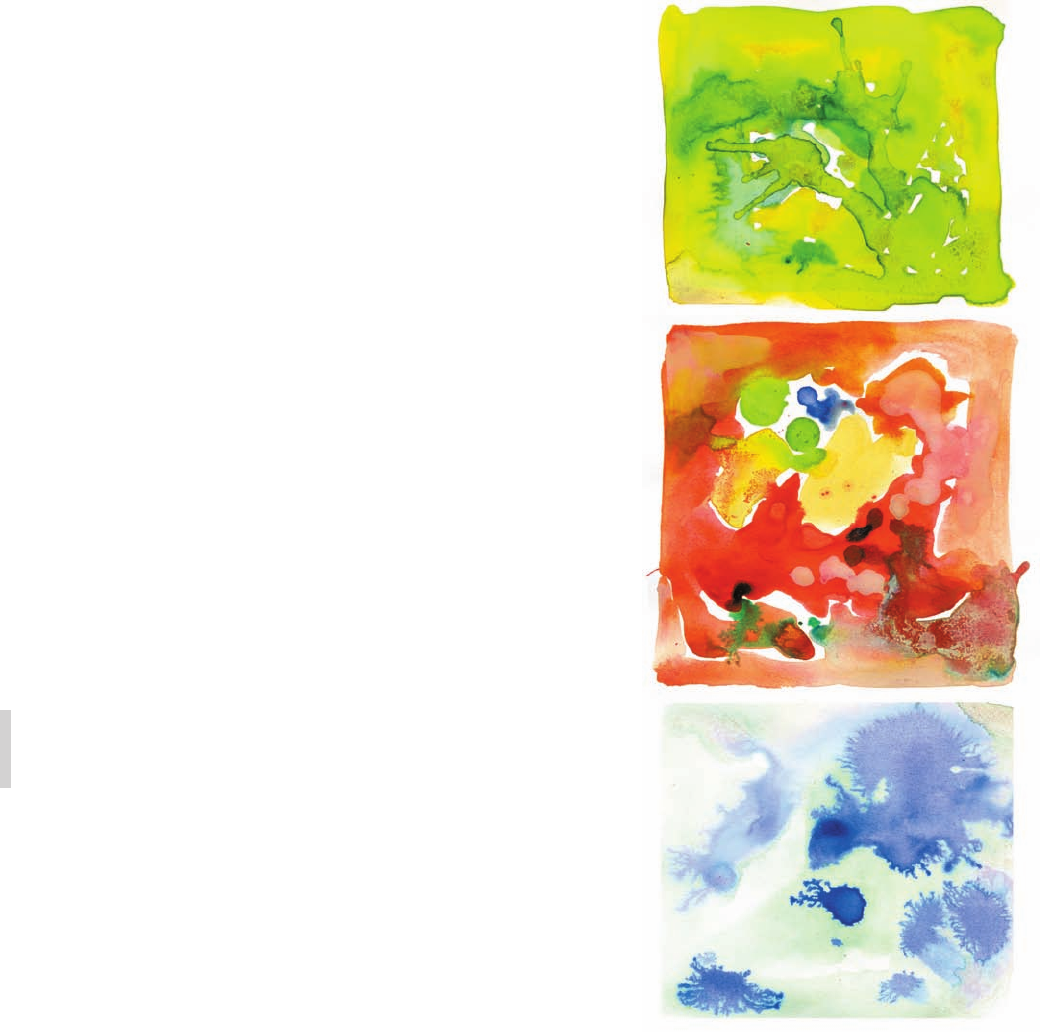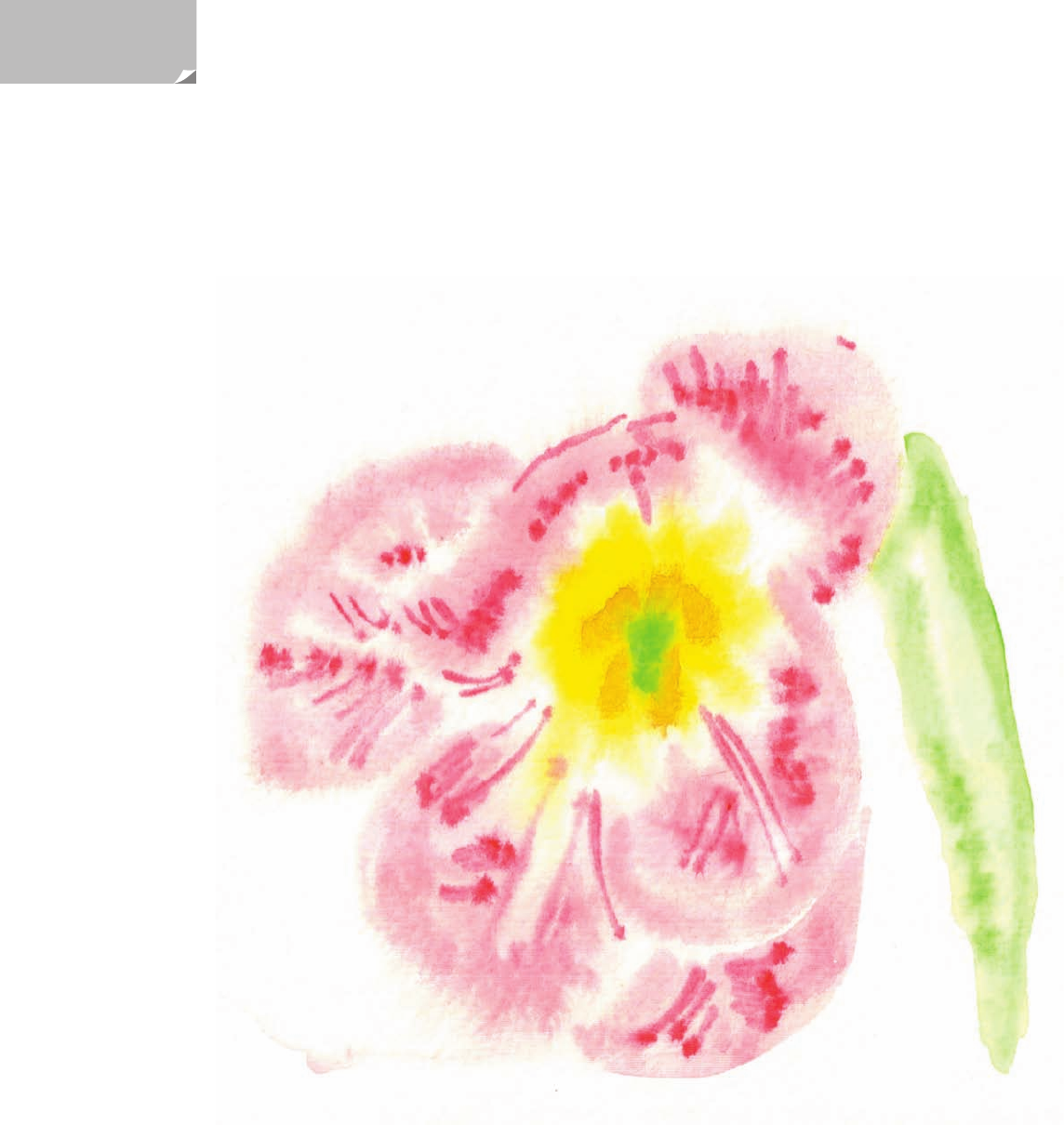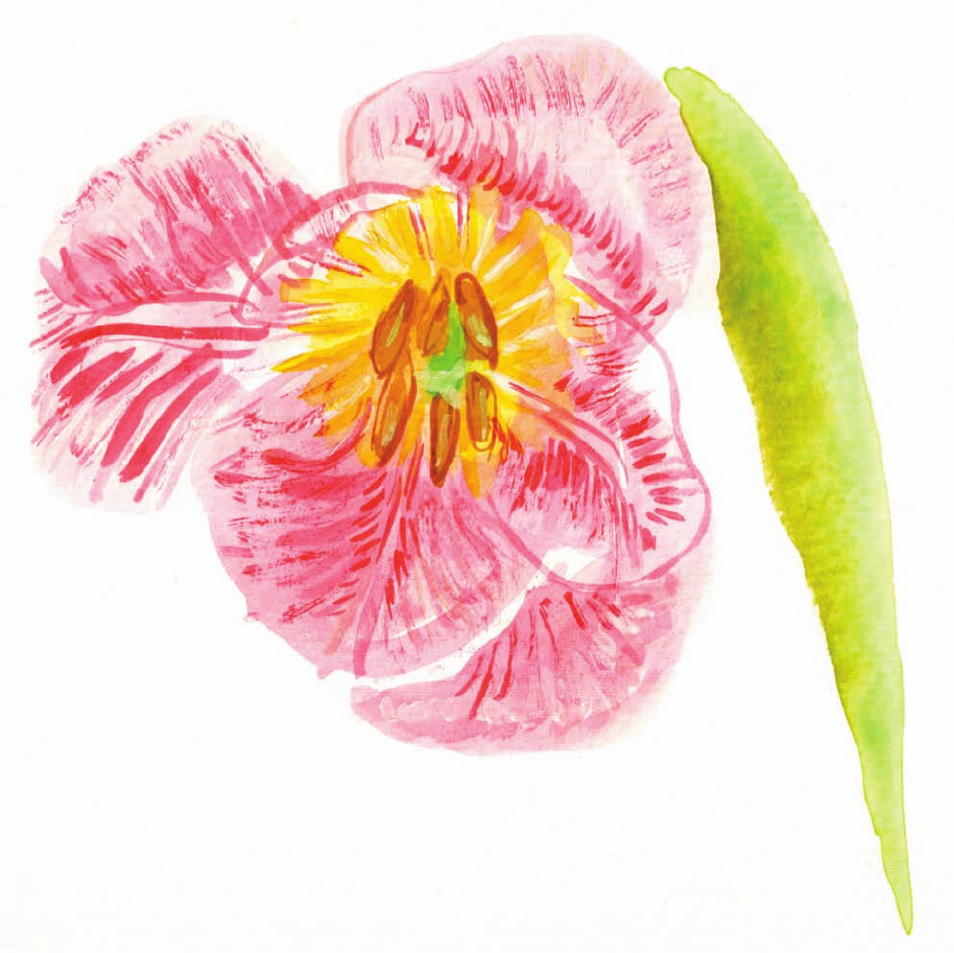
(Ray)
(Fogra 29_WF)Job:07-30996 Title:RP-One Watercolor A Day
#175 Dtp:225 Page:15
001-027_30996.indd 15 8/1/13 5:12 PM
M ATERIALS A N D TECH N I QUES 1 5
(Text)
Green. You’ll see that the secondary colors live in the
halfway position between each primary. Mix a primary with a
secondary color to get a tertiary color (C). The tertiary colors
are Yellow-Orange, Red-Orange, Red-Violet, Blue-Violet,
Blue-Green, and Yellow-Green.
Colors that are next to each other on the color wheel are
analogous: for example, Yellow-Green, Yellow, and Yellow-
Orange. Opposing colors on the wheel are known as
complementary: for example, Red and Green. And each color
has what’s known as its split complementary: for example,
the split complementaries of Blue are Yellow-Orange and
Red-Orange. The complementary of Blue is Orange, so its
split complementary colors sit on either side of the Orange
panel. You can be very deliberate with these color “systems”
when you paint, as you can see in Michele’s beautiful
example of a limited palette painting above. For an image of
tranquility in Newport, Rhode Island, she used only two
primaries and a secondary: Blue, Yellow, and Green.
Newport, Rhode Island, watercolor
(Ray)
(Fogra 29_WF)Job:07-30996 Title:RP-One Watercolor A Day
#175 Dtp:225 Page:15
001-027_30996.indd 15 8/1/13 5:10 PM

(Ray)
(Fogra 29_WF)Job:07-30996 Title:RP-One Watercolor A Day
#175 Dtp:225 Page:16
001-027_30996.indd 16 8/1/13 5:12 PM
16 O N E WATERCOLOR A DAY
(Text)
DAY 1
Abstraction, watercolor on paper
(Ray)
(Fogra 29_WF)Job:07-30996 Title:RP-One Watercolor A Day
#175 Dtp:225 Page:16
001-027_30996.indd 16 8/1/13 5:10 PM

(Ray)
(Fogra 29_WF)Job:07-30996 Title:RP-One Watercolor A Day
#175 Dtp:225 Page:17
001-027_30996.indd 17 8/1/13 5:12 PM
M ATERIALS A N D TECH N I QUES 1 7
(Text)
Let’s Paint
EXERCISE 1
Before we begin our exploration of watercolor, we first have to (literally) get
our hands a bit dirty. For the first exercise in this book, we are simply going
to experience the aesthetics of watercolor and begin putting paints down on
the page. Paint them with a brush, drip them, throw them! Channel your inner
Jackson Pollack, as Eddie has done in this series of paintings.
You might try different combinations of colors. Eddie’s abstract painting at
left is predominantly reds and blues, with a little yellow dropped in for a pop
of something else. Try all kinds of combinations: greens and browns; purples,
oranges, and yellows; pinks and grays with blacks; and so on.
Take some time with this, and create a lot of different combinations. You
might even cut them out like little swatches of possibilities. A book such as
that could be a wonderful thing to look back at as a self-reference of color.
Don’t be afraid to “waste” the paints. Getting familiar with your materials is
never a waste of time or paint, but an exercise that pays off in the long run.
TIP
• Put all of your colors in front of you before you start this exercise. Having
them in easy reach allows your color taste and intuition to take over.
Color Swatches, watercolor on paper
(Ray)
(Fogra 29_WF)Job:07-30996 Title:RP-One Watercolor A Day
#175 Dtp:225 Page:17
001-027_30996.indd 17 8/1/13 5:10 PM

(Ray)
(Fogra 29_WF)Job:07-30996 Title:RP-One Watercolor A Day
#175 Dtp:225 Page:18
001-027_30996.indd 18 8/1/13 5:12 PM
18 ONE WATERCO L O R A DAY
(Text)
DAY 2
“Looking into a tulip. The first watercolor is wet on wet. A spreading
experience! The second watercolor is wet on dry. A more defining
experience! Both offered me a very different experience and result—hard
to pick a favorite. Although to be honest, I do like making a lot of marks
and giving definition.” —Margaret
Tulip, wet-on-wet watercolor
Two
Flowers
(Ray)
(Fogra 29_WF)Job:07-30996 Title:RP-One Watercolor A Day
08-C69590 #175 Dtp:225 Page:18
001-027_C69590.indd 18 8/27/13 7:20 PM

(Ray)
(Fogra 29_WF)Job:07-30996 Title:RP-One Watercolor A Day
#175 Dtp:225 Page:19
001-027_30996.indd 19 8/1/13 5:12 PM
M ATERIALS A N D TECH N I QUES 1 9
(Text)
EXERCISE 2
Choose one flower, such as a tulip, and make two paintings
of it. For the first painting, we will do a wet-on-wet technique.
What this means is that you first wet the paper and then apply
your paint to the wet paper before it dries. You can add some
details, but not too many, because too much pigment on the
wet paper will start to get muddy. Look at how Margaret has
added a few pink lines and the green and yellow ochre shapes
to her initial washes of color. For the second painting, you
will work with wet paint on a dry sheet of paper. Add details
on top of the washes after the initial flower shape has dried.
Hot or cold press watercolor paper can work for this exercise,
although the cold press will allow the wet-on-wet color to
spread a bit more. Notice the difference in the feel of the two
techniques. You can use this knowledge in many of the
exercises in this book.
Tulip, wet-on-dry watercolor
(Ray)
(Fogra 29_WF)Job:07-30996 Title:RP-One Watercolor A Day
#175 Dtp:225 Page:19
001-027_30996.indd 19 8/1/13 5:10 PM
..................Content has been hidden....................
You can't read the all page of ebook, please click here login for view all page.
